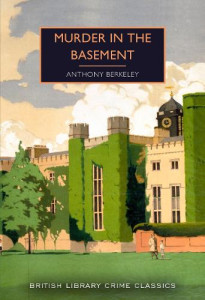 Anthony Berkeley’s Murder in the Basement features a decided unusual twist for fiction in the age it was originally published. Specifically, one of the few wherein the identity of the victim is a major mystery that needs to be solved before one can switch and find the identity of the murderer. It is a storytelling style that would become much more popular in later years, however would prove even this early that it was a very valid formula.
Anthony Berkeley’s Murder in the Basement features a decided unusual twist for fiction in the age it was originally published. Specifically, one of the few wherein the identity of the victim is a major mystery that needs to be solved before one can switch and find the identity of the murderer. It is a storytelling style that would become much more popular in later years, however would prove even this early that it was a very valid formula.
While moving into a new house, a couple discovers something strange in the basement which turns out to be the dead body of the titular crime. Chief Inspector Moresby, working somewhat with a more amateur sleuth named Roger Sheringham, has the unenviable task of not only solving the crime but even discovering who exactly was the victim. The existence of a bullet wound, unmistakable, isn’t much of a place to start and most see it as a lost cause until quite late in the investigation.
Preparatory school politics are a major aspect of this book, particularly the middle section which is used to provide motives to a wide assortment of potential suspects. Indeed one young woman’s desire to use her position to “clean house” could seem especially suspicious to an outsider, as could the gossiping that occurs. Those familiar with an office environment, school or not, will recognise the large assortment of personality conflicts and maneuvers that happen in the section. While it will seem unlikely that many of these people are sufficiently motivated to murder by what is seen, the relative authenticity combines well with other evidence and details goven to form a suitable picture.
There will always be those who disapprove of large second narratives inside of a first, but with the pedigree going back to A Study in Scarlet mysteried have more than proven that they can be successful. In this case, notes by one individual paint a clear picture of the school, helping to prove a fairly definitive look at the characters as the conflict that led to the death would build, albeit without making a clear decision on the guilty party.
The use of forensics related to a fairly long dead, indeed twice buried, corpse in the movie is an unusual but understandable issue. The relatively modern use of plates to help bones knit, and with that the question of successfully making them tell the investigators something about the victim. It is true that part of their gaining knowledge comes from happenstance, however even this happenstance is more finding a rare detail through careful investigative work. With series like Bones making such matters common on television, and such forensics being used in mystery novels even longer, it is good to see such a relatively early example of them here. The further investigative work this leads to only increases the nature of that as impressive, as it is a nice example of believable and engaging investigation.
Like most British Library Crime Classics, this volume sports a very nice introduction as well as a note from the publisher. Originally released in 1932, the book definitely represents an example of pre World War II detective fiction from one of its more celebrated writers of the time. While this is not the first book Sheringham appears in, it is more than an adequate introduction to the character. Anyone interested in this era of mystery novel would do well to check it out, and fans of the cozy mystery or forensic mystery in general will find it especially interesting from a historical point of view.
( British Library 2022)
